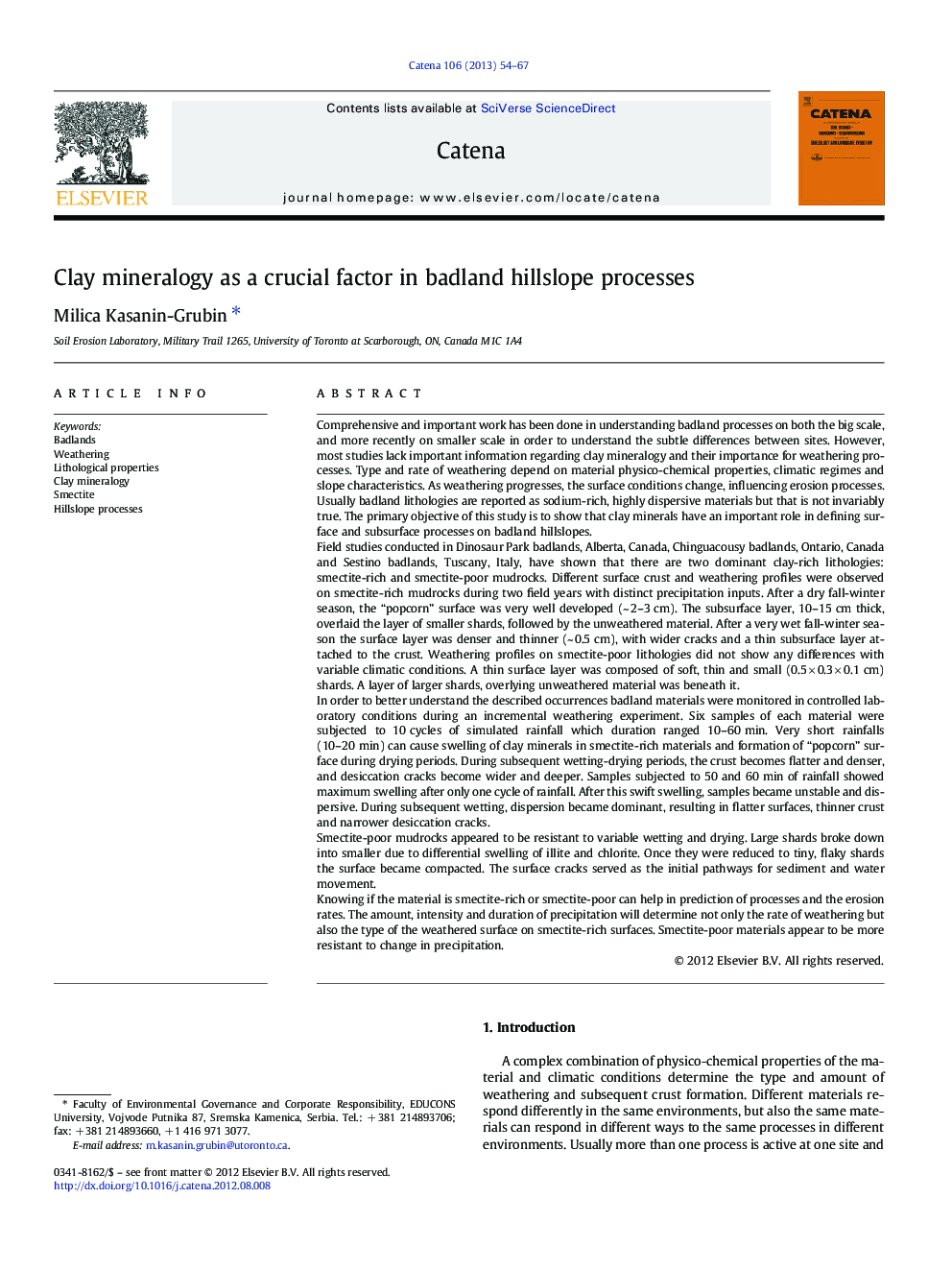| کد مقاله | کد نشریه | سال انتشار | مقاله انگلیسی | نسخه تمام متن |
|---|---|---|---|---|
| 4571707 | 1629246 | 2013 | 14 صفحه PDF | دانلود رایگان |

Comprehensive and important work has been done in understanding badland processes on both the big scale, and more recently on smaller scale in order to understand the subtle differences between sites. However, most studies lack important information regarding clay mineralogy and their importance for weathering processes. Type and rate of weathering depend on material physico-chemical properties, climatic regimes and slope characteristics. As weathering progresses, the surface conditions change, influencing erosion processes. Usually badland lithologies are reported as sodium-rich, highly dispersive materials but that is not invariably true. The primary objective of this study is to show that clay minerals have an important role in defining surface and subsurface processes on badland hillslopes.Field studies conducted in Dinosaur Park badlands, Alberta, Canada, Chinguacousy badlands, Ontario, Canada and Sestino badlands, Tuscany, Italy, have shown that there are two dominant clay-rich lithologies: smectite-rich and smectite-poor mudrocks. Different surface crust and weathering profiles were observed on smectite-rich mudrocks during two field years with distinct precipitation inputs. After a dry fall-winter season, the “popcorn” surface was very well developed (~ 2–3 cm). The subsurface layer, 10–15 cm thick, overlaid the layer of smaller shards, followed by the unweathered material. After a very wet fall-winter season the surface layer was denser and thinner (~ 0.5 cm), with wider cracks and a thin subsurface layer attached to the crust. Weathering profiles on smectite-poor lithologies did not show any differences with variable climatic conditions. A thin surface layer was composed of soft, thin and small (0.5 × 0.3 × 0.1 cm) shards. A layer of larger shards, overlying unweathered material was beneath it.In order to better understand the described occurrences badland materials were monitored in controlled laboratory conditions during an incremental weathering experiment. Six samples of each material were subjected to 10 cycles of simulated rainfall which duration ranged 10–60 min. Very short rainfalls (10–20 min) can cause swelling of clay minerals in smectite-rich materials and formation of “popcorn” surface during drying periods. During subsequent wetting-drying periods, the crust becomes flatter and denser, and desiccation cracks become wider and deeper. Samples subjected to 50 and 60 min of rainfall showed maximum swelling after only one cycle of rainfall. After this swift swelling, samples became unstable and dispersive. During subsequent wetting, dispersion became dominant, resulting in flatter surfaces, thinner crust and narrower desiccation cracks.Smectite-poor mudrocks appeared to be resistant to variable wetting and drying. Large shards broke down into smaller due to differential swelling of illite and chlorite. Once they were reduced to tiny, flaky shards the surface became compacted. The surface cracks served as the initial pathways for sediment and water movement.Knowing if the material is smectite-rich or smectite-poor can help in prediction of processes and the erosion rates. The amount, intensity and duration of precipitation will determine not only the rate of weathering but also the type of the weathered surface on smectite-rich surfaces. Smectite-poor materials appear to be more resistant to change in precipitation.
► Clay minerals have an important role in defining surface and subsurface processes on badland hillslopes.
► Badland materials were monitored in controlled laboratory conditions during an incremental weathering experiment.
► Knowing if the material is smectite-rich or smectite-poor can help in prediction of processes and the erosion rates.
► Precipitation characteristics will determine the rate of weathering on smectite-rich surfaces.
► Smectite-poor materials appear to be more resistant precipitation characteristics.
Journal: CATENA - Volume 106, July 2013, Pages 54–67